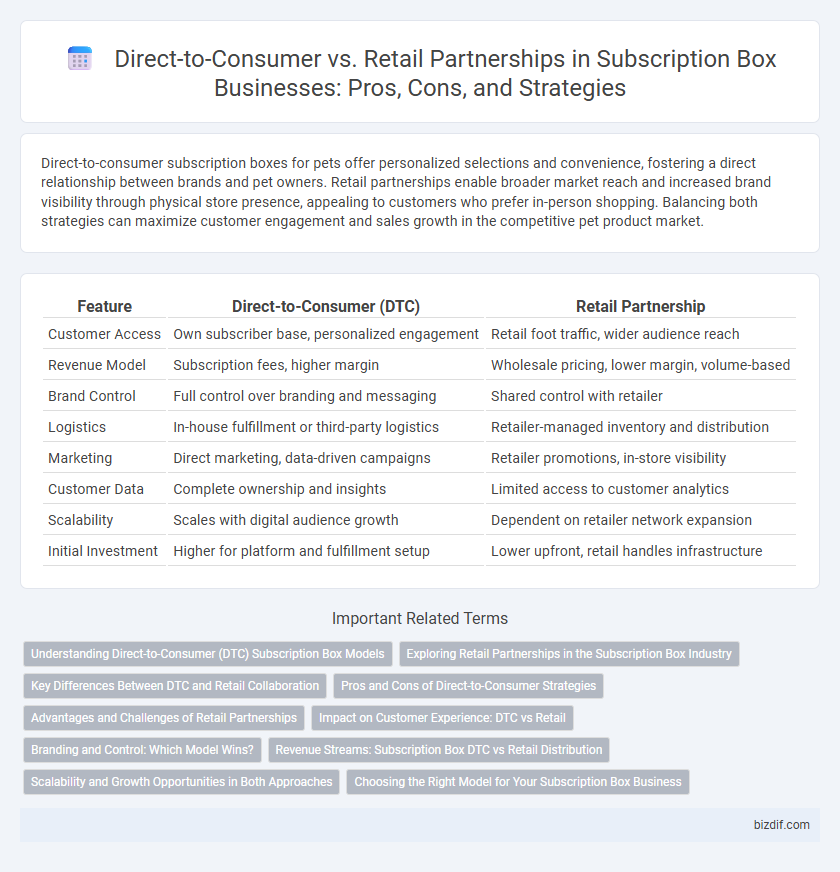Direct-to-consumer subscription boxes for pets offer personalized selections and convenience, fostering a direct relationship between brands and pet owners. Retail partnerships enable broader market reach and increased brand visibility through physical store presence, appealing to customers who prefer in-person shopping. Balancing both strategies can maximize customer engagement and sales growth in the competitive pet product market.
Table of Comparison
| Feature | Direct-to-Consumer (DTC) | Retail Partnership |
|---|---|---|
| Customer Access | Own subscriber base, personalized engagement | Retail foot traffic, wider audience reach |
| Revenue Model | Subscription fees, higher margin | Wholesale pricing, lower margin, volume-based |
| Brand Control | Full control over branding and messaging | Shared control with retailer |
| Logistics | In-house fulfillment or third-party logistics | Retailer-managed inventory and distribution |
| Marketing | Direct marketing, data-driven campaigns | Retailer promotions, in-store visibility |
| Customer Data | Complete ownership and insights | Limited access to customer analytics |
| Scalability | Scales with digital audience growth | Dependent on retailer network expansion |
| Initial Investment | Higher for platform and fulfillment setup | Lower upfront, retail handles infrastructure |
Understanding Direct-to-Consumer (DTC) Subscription Box Models
Direct-to-consumer (DTC) subscription box models enable brands to build personalized customer relationships by selling products directly through their own platforms, bypassing traditional retail channels. This approach allows for greater control over customer data, personalized marketing, and subscription customization, leading to higher customer retention and lifetime value. DTC models also facilitate faster feedback loops and product innovation due to direct interactions with subscribers.
Exploring Retail Partnerships in the Subscription Box Industry
Exploring retail partnerships in the subscription box industry expands brand visibility by reaching customers beyond direct-to-consumer channels, leveraging established retail networks for increased distribution. Collaborations with retail partners can enhance customer trust and offer tangible experiences, driving subscription growth through integrated marketing efforts. Data from industry reports show that subscription services utilizing retail partnerships often see a 20-30% increase in subscriber acquisition compared to direct sales alone.
Key Differences Between DTC and Retail Collaboration
Direct-to-consumer (DTC) subscription boxes offer brands complete control over customer experience, pricing, and data collection, allowing for personalized marketing strategies and higher profit margins. Retail partnerships distribute subscription boxes through established physical or online stores, expanding reach and brand visibility but often involving revenue sharing and less control over consumer interactions. Key differences include ownership of customer data, margin structure, and the degree of brand experience management.
Pros and Cons of Direct-to-Consumer Strategies
Direct-to-consumer (DTC) subscription box strategies enable brands to maintain full control over customer experience, data collection, and profitability by bypassing traditional retail intermediaries. This approach fosters stronger brand loyalty and personalized marketing but requires significant investment in fulfillment infrastructure and customer acquisition. However, DTC models can face challenges scaling quickly and reaching new markets compared to retail partnerships that offer established distribution networks and retail visibility.
Advantages and Challenges of Retail Partnerships
Retail partnerships offer expanded customer reach and increased brand visibility by leveraging established physical stores and foot traffic. Challenges include lower profit margins due to retailer commissions and potential loss of direct customer data, which can hinder personalized marketing efforts. Navigating inventory management and maintaining consistent brand experience across multiple retail locations also require strategic coordination.
Impact on Customer Experience: DTC vs Retail
Direct-to-consumer subscription boxes provide personalized customer experiences through tailored products and direct feedback channels, enhancing satisfaction and loyalty. Retail partnerships offer broader accessibility and immediate product availability but may dilute brand-specific engagement due to third-party control. The DTC model fosters stronger brand-consumer relationships by leveraging data insights for customization, contrasting with retail's emphasis on convenience and reach.
Branding and Control: Which Model Wins?
Direct-to-consumer subscription boxes offer brands full control over packaging, messaging, and customer experience, ensuring consistent and tailored brand identity. Retail partnerships require sharing branding control, often diluting the brand's unique voice due to retailer guidelines and broader market positioning. For brands prioritizing strong, cohesive branding and direct consumer insights, the direct-to-consumer model typically wins in maintaining control and optimizing brand impact.
Revenue Streams: Subscription Box DTC vs Retail Distribution
Direct-to-consumer (DTC) subscription boxes generate predictable monthly revenue through recurring customer payments, enhancing cash flow and customer lifetime value. In contrast, retail partnerships rely on wholesale orders and one-time purchases, leading to less predictable but larger upfront revenue bursts. Subscription box DTC models benefit from direct customer data, enabling personalized marketing and higher profit margins compared to retail distribution channels.
Scalability and Growth Opportunities in Both Approaches
Direct-to-consumer subscription boxes offer greater scalability by allowing brands to control customer data and tailor personalized experiences, fostering higher customer retention and lifetime value. Retail partnerships expand market reach rapidly but often involve lower margins and less direct communication with end consumers, which can limit long-term growth insights. Balancing direct sales with strategic retail alliances maximizes growth potential by combining personalized engagement with broader brand exposure.
Choosing the Right Model for Your Subscription Box Business
Direct-to-consumer subscription boxes enable brands to maintain full control over customer experience and data, fostering personalized marketing and higher profit margins. Retail partnerships offer expanded reach and instant credibility but often require sharing revenue and yielding some control over branding. Selecting the right model depends on factors like target audience, budget, scalability goals, and desired customer engagement.
Direct-to-consumer vs Retail partnership Infographic

 bizdif.com
bizdif.com